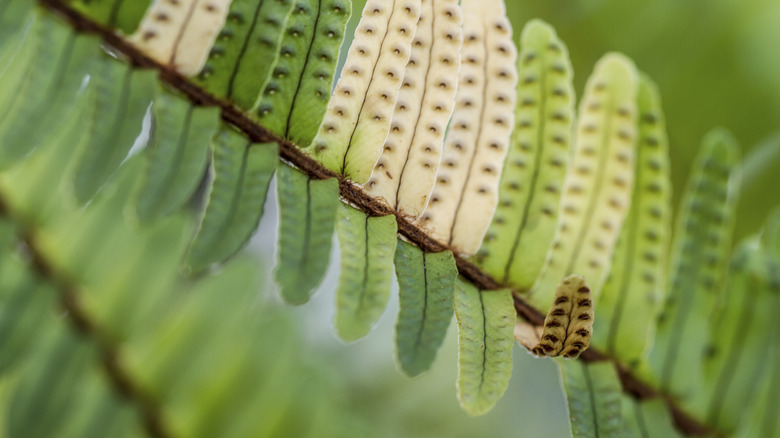Dark Brown Spots On Underside Of Fern Leaf
Dark brown spots on the underside of a fern leaf are probably just a sign the fern is ready to reproduce. Ferns are a large plant family that includes indoor varieties, such as Boston fern (Nephrolepis exaltata), which grows outdoors in U. S. Department of Agriculture plant hardiness zones 10 through 12, and garden ferns like Japanese shield fern (Dryopteris erythrosora), which is hardy USDA zones 5 through 8. Brown spots on ferns might also be a sign of pest or disease infestations.
Spore Cases
Dark brown spots in a regular pattern on the underside of a fern leaf are usually spore cases. Fern reproduction is a two-stage process. In the first stage, ferns produce spores — tiny, dust-like particles — in brown spore cases on the undersides of their leaves. When the spore cases mature, they open and release the spores, which fall to the soil. The spores sprout and grow into small, heart-shaped plants. In the second stage of fern reproduction, these small plants release male or female cells. When male and female cells meet, they form an embryo, which develops into a fern plant.
New Ferns
Gardeners can grow new ferns by collecting spores from a fern leaf. There are three methods for growing new ferns — planting offshoots, dividing plants and sprouting fern spores. Tie a paper envelope around a fern leaf with brown spots when the spots are thick and have stopped growing larger. Protect the envelope from the rain with a plastic sheet if the fern is outdoors, and check the envelope weekly for spores, which look like fine, brown dust. Sprinkle the spores very thinly on a shallow pot of moistened, 50-to-50 mixture of fine compost and sand, and cover the pot with clear plastic. Transfer the small plants that appear to a flat tray of moist, fine leaf mold, and space them 1 inch apart. Mist the plants twice daily with clean water, and transplant the ferns that appear into individual pots with drainage holes when about 2 inches tall.
Scale Insects
Scale insects infest the underside of fern leaves and can look like brown spots. Hard-bodied insects without visible legs, scale insects look like tiny brown or white seashells. Fern scale and hemispherical scale feed on ferns. Unlike spore cases, scale insects appear in an irregular pattern on fern leaves and often cluster near the midribs. Ferns are sensitive to most pesticides, but horticultural oils can control scale insects. Dilute a 97-percent horticulture oil product at a rate of 2 1/2 fluid ounces per 1 gallon of water, and spray outdoor ferns when temperatures are between 40 and 85 degrees Fahrenheit on a still, cloudy, dry day. Covering all plant parts, spray the ferns every two weeks up to four times. Don't use horticultural oil on maidenhair fern (Adiantum capillus-veneris), which is hardy in USDA zones 5 through 8, and don't use it on indoor ferns. Indoor ferns are unlikely to recover from a scale infestation and should be thrown out before the scales spread to other plants. Observe label safety precautions when handling and mixing horticulture oils.
Bacterial Infection
Translucent spots that turn brown could be a sign of bacterial infection on a fern leaf. Bird's nest fern (Asplenium nidus) and other ferns in the Asplenium family are susceptible to a disease called bacterial blight or leaf spot, which is caused by Pseudomonas cichorii and Pseudomonas gladioli bacteria. Translucent spots appear on leaves and over time, grow larger and turn yellow, brown or reddish-brown with purple halos. Examine ferns thoroughly for leaf spots before you buy them, and don't water the plants from overhead because this encourages the disease to develop. Throw infected ferns in the trash. Bird's nest fern is usually grown as an indoor plant but grows outside in USDA zones 11 through 12.
References
- University of Georgia Cooperative Extension: Growing Ferns
- Pennsylvania State University Extension: Fern Diseases
- University of Minnesota Extension: Bacterial Leaf Diseases of Foliage Plants
- Missouri Botanical Garden: Asplenium Nidus
- Missouri Botanical Garden: Nephrolepis Exaltata
- Missouri Botanical Garden: Dryopteris Erythrosora
- Missouri Botanical Garden: Adiantum Capillus-Veneris
